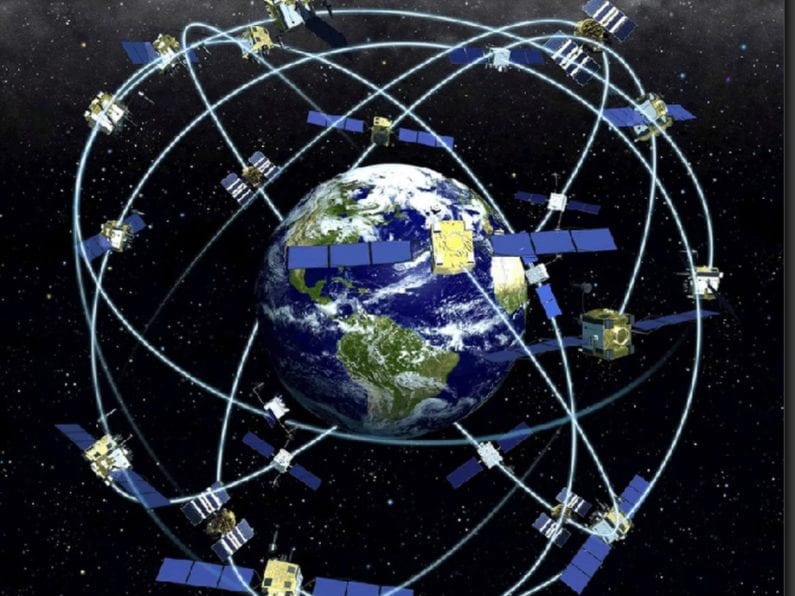Latest News

An artistic rendering of GPS satellites in orbit. Photo Credit: NOAA
The fundamentals of spectrum policy can be complicated and confusing, and, as the need for spectrum increases, it’s more important than ever to understand how and why our communication and navigation systems are set up the way that they are. At the same time, debates over harmful interference and the coexistence of divergent services are raging. Nowhere are the differences more apparent than when comparing radio navigation services like GPS to radio communications systems used in wireless networks.
Let’s start with some of the basics. Communications systems operate at very high power levels and above the noise floor (i.e., the level of noise occurring naturally at a receiver before a new signal is introduced). GPS signals, on the other hand, are very low power, operating below the noise floor. This reality — a solar powered satellite system transmitting from roughly 12,000 miles above the Earth — means that an increase in the noise floor has a far greater effect on the reception and processing of GPS signals than on high power terrestrial communications signals.
So how do we ensure, both here in the U.S. and around the world, that a satellite-based radio navigation service like GPS is protected from harmful interference? Thankfully, there is guidance in the form of an international definition of harmful interference, which states, “Interference which endangers the function of a radio navigation service…”[1]. With this foundational definition, the internationally established criteria of a 1 decibel (dB) increase in the noise floor, otherwise known as the “1 dB Standard,” provides the answer, offering a readily identifiable, objective, and predictable metric.
The 1 dB Standard uses a 1 dB increase in the noise floor as the threshold between tolerable interference and harmful interference (this can be reliably measured by a 1 dB decrease in the Carrier-to-Noise Ratio (C/N0) reported by the receiver). Thus, the 1 dB Standard provides a definitive way to protect GPS receivers from harmful interference. Adherence to this standard helps ensure that systems operating in an adjacent spectrum band do not interfere with GPS.
Some might ask, why use the 1 dB Standard instead of other metrics? The 1 dB Standard is based upon well understood Global Navigation Satellite System (GNSS) engineering considerations and is associated with quantifiable changes in the overall noise to which GNSS receivers are subject, with equally well understood effects on receiver operation (GPS is the GNSS operated by the United States). The 1 dB Standard enables system designers and spectrum regulators to carefully assess interference from various sources and analyze the net effect on GNSS receivers. It also has been adopted internationally and has a long and well-established proven history of protecting GPS operations from harmful interference in both international and domestic regulatory proceedings.
While proponents of so-called “alternatives” to 1 dB claim that those approaches will protect the billions of GNSS receivers found worldwide, I would like to explain why they do not hold up under scrutiny. For example, some proponents suggest the use of KPIs to determine harmful interference to GPS. These KPIs are computed further downstream in the receiver, which means that harmful interference may have already occurred, whereas C/N0 is computed at an entry point of GPS receivers, and 1 dB degradation of C/N0 serves as an early warning of interference that is potentially harmful.
Consequently, this explains why the suggestion that the standard be based on whether there is actual harm to a receiver is severely misleading. Further, “actual” harm to an individual GPS receiver wrongly assumes that one can accurately predict the impact of a new service across a wide variety of GPS devices. The universe of GPS devices is broad and diverse. Think, for example about the requirements for a GPS receiver found in an airplane versus the one found in your smartphone. Next, evaluating multiple KPIs across innumerable permutations of devices, operational scenarios, and measurements is logistically and administratively impossible. Various devices operate in a host of different operational scenarios, and perform diverse measurements. Finally, such an approach would not only limit, but also undermine technological innovation. Today’s KPIs may not protect tomorrow’s devices. Accurately predicting the impact of a new service requires a universal metric— the 1 dB Standard, which provides one well understood measurement that applies to all receivers and operational scenarios.
Finally, some stakeholders have proposed using “harm claim thresholds,” a defined threshold above which end users can register complaints of harmful interference. While this approach is often billed as a means of streamlining the regulatory process and expediting the deployment of new entrants and services, reliance on harm claim thresholds in the context of GPS overlooks two key issues. First, under the harm claim threshold approach, the burden to prove harmful interference is shifted to incumbent users of safety-of-life spectrum, who are then compelled to initiate a long regulatory process to seek redress only after interference and harm have occurred. This is not only inappropriate, but could prove catastrophic for safety-of-life services that depend on GPS, including certified aviation, autonomous vehicle sensors, earthquake monitoring, E911, and search and rescue. Second, harm claim thresholds defined around anything other than the 1 dB Standard suffer from all of the shortcomings described above, especially the need to quantify potential interference impact to endless combinations of devices, scenarios, and tests.
Ultimately, what impact could these alternatives to the 1 dB Standard have on the user experience? While interference between mobile communications networks, results in observable behaviors such as dropped calls or reduced call quality, GPS operates very differently. The accuracy, integrity, and reception (availability) of GPS signals used by a receiver can be degraded by interfering noise in ways not immediately apparent to an end user. This mean the effects of degraded service of GPS signals can still be very detrimental well before the user loses position accuracy or experiences complete loss of position.
GPS has become a fundamental part of our lives. From driving directions to rideshare services to public safety response, to precision agriculture and beyond, GPS is an integral engine of the U.S. economy, creating new jobs, and unlocking innovation. Maintaining the 1 dB Standard ensures that the GPS success story and American innovation will continue for decades to come.
[1] International Telecommunications Union – Radiosector (ITU-R): Harmful Interference: “Interference which endangers the functioning of a radionavigation service, or of other safety services, or seriously degrades, obstructs, or repeatedly interrupts a radiocommunication service operating in accordance with the radio regulations.”
 J. David Grossman is the executive director for the GPS Innovation Alliance.
J. David Grossman is the executive director for the GPS Innovation Alliance.
Get the latest Via Satellite news!
Subscribe Now